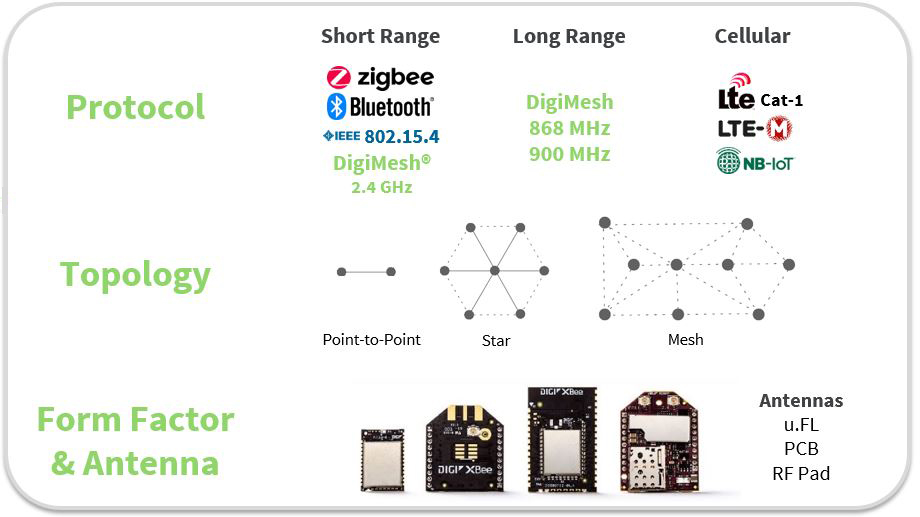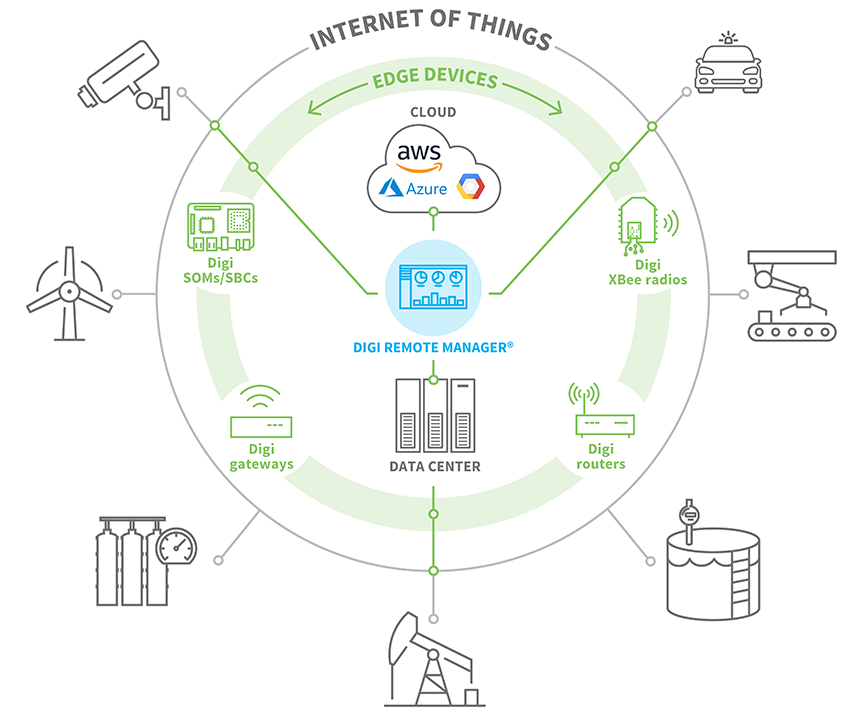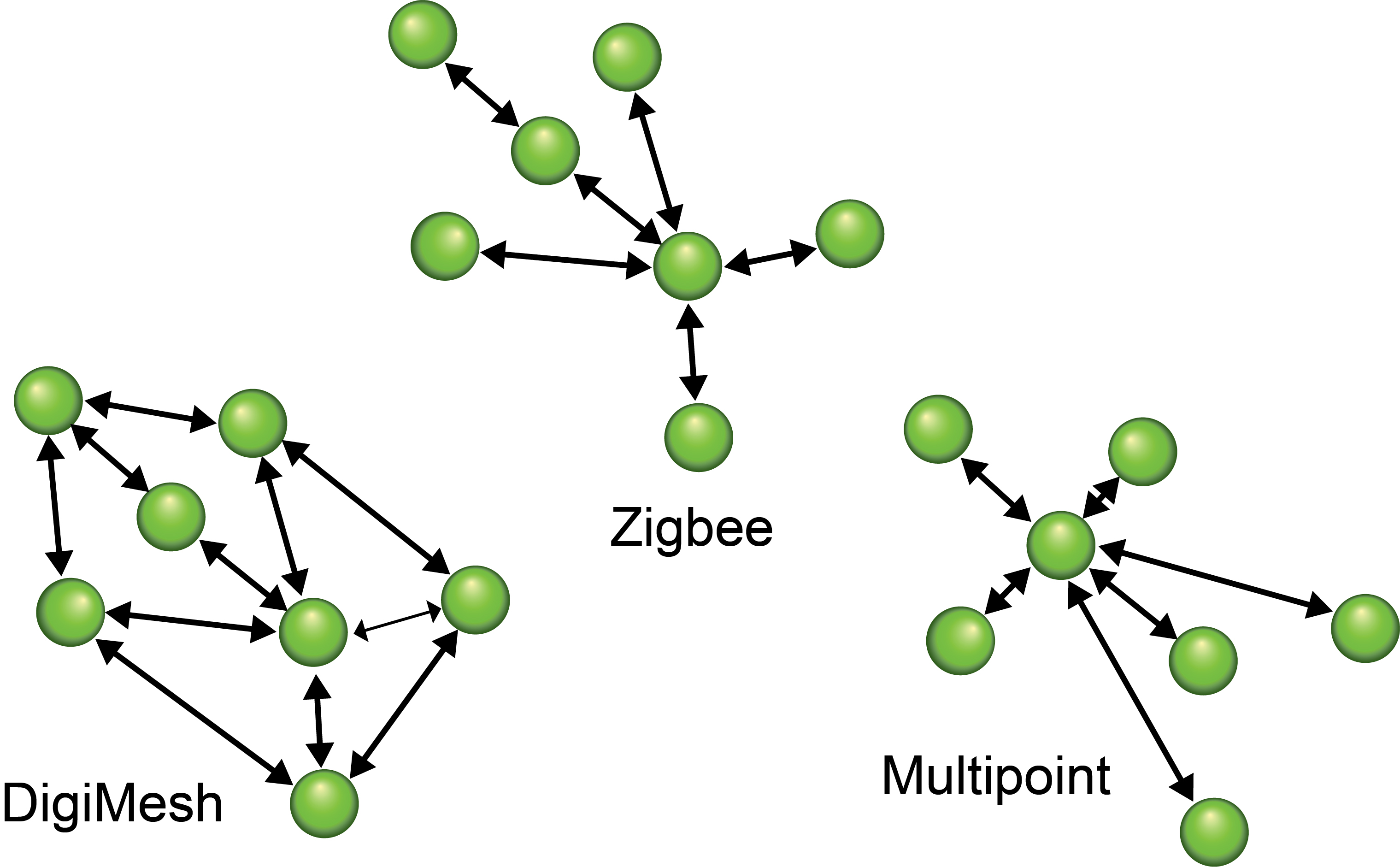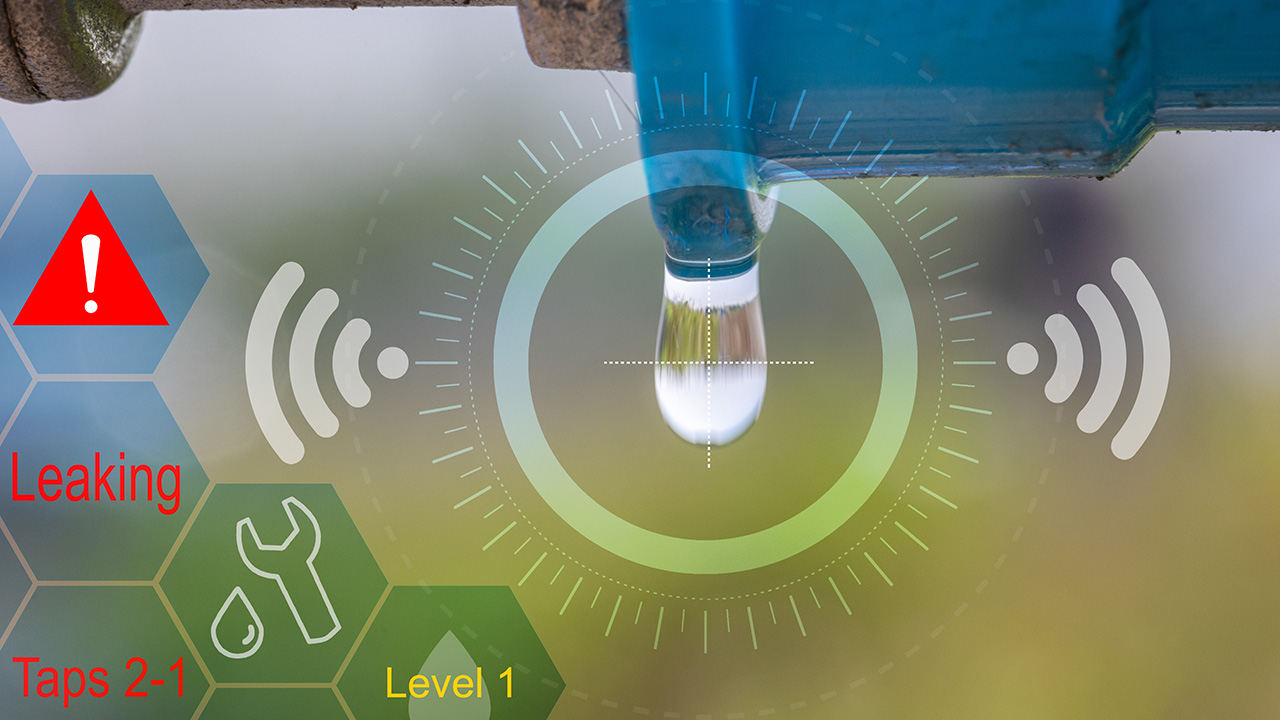One of the first choices you'll make when designing an IoT system is how it will communicate. While some projects can be hardwired using Ethernet or a serial protocol, most require the mobility and agility that comes with wireless communication.
IoT devices are often situated in places where cabling for power or communications is impractical, and many are entirely mobile, making any kind of wired solution out of the question. In these cases, choosing a wireless communication protocol is a no-brainer. But which wireless solution is right for your project?
In this post we compare cellular communication to RF communication (radio frequency protocols), examining the key considerations to help you make the best choice. Our examples will focus on Digi XBee® modules, but the considerations are the same no matter what make and model of wireless communications you implement in your project.
Take me to the XBee Ecosystem of RF and Cellular Modems
For cellular we'll look at the low-bandwidth protocols supported by the Digi XBee Cellular line, including LTE Cat 1, LTE-M and NB-IoT. Digi also offers a wide selection of non-cellular radio frequency solutions. We refer to this as our "RF" line of Digi XBee modules including: the XBee 3 Zigbee, XBee 3 DigiMesh, and XBee 3 802.15.4; the XBee-PRO Zigbee and XBee-PRO DigiMesh; the XBee SX 900 and XBee 868MHz; and the XBee-PRO 900HP.
Refer to the XBee Buying Guide to compare the capabilities of the different modules in the Digi XBee ecosystem.

Comparing RF vs. Cellular Wireless Communications
The best wireless communication solution for any IoT system is always context dependent. For some projects, cellular will be the best fit. For others, cellular's power requirements and costs might be prohibitive and a short-range RF solution like Digi XBee 3 Zigbee will be the ideal matchup. The reason there are so many different IoT protocols is that there are so many different types of projects, each with unique requirements. With this in mind, let's look at the considerations for each type of solution.
Cellular Communications: Advantages and Trade-offs

As with every wireless communication option, with cellular there are considerations from cost and complexity to the time required to design and build a solution, and how you or your end customers will ultimately manage the device. For example, you will need to ensure your product’s firmware can be regularly updated with security or functionality updates and that your wireless communication devices are online and functioning properly.
Cellular solutions require external infrastructure. Two cellular modules never talk to each other directly; they must connect through a wireless carrier's network using its vast array of communications towers and considerable back-end infrastructure. When we say that a cellular module talks to "the tower" we are really referring to that carrier's full network, as represented by a single cell tower. Because cellular requires infrastructure, a paid data plan from a wireless carrier is almost always required. Even with reduced cost plans for low-bandwidth IoT devices, total charges can be significant, and for some projects, prohibitive.
Advantages of Cellular Communication

A cellular communication module talks directly to any tower in range, and uses that connection to communicate directly, typically to online cloud applications. A key advantage of choosing cellular for your wireless communication method is that no other equipment is required; the module and its antenna are all you need.
Cellular solutions are extremely mobile. Their connections can be handed off from tower-to-tower at high speeds. With the right module and data plan, your IoT device can move seamlessly around the globe without losing connectivity. Keep in mind that every module must be within the radio range of a tower to communicate. If a wireless carrier does not cover an area, cellular communications will not be possible there.
Cellular data is IP native, meaning that cell modules with live connections can converse with the Internet directly in its native language. This reduces development work and simplifies IoT network architecture. It also makes over-the-air updates relatively straightforward since firmware can be passed directly from the cloud to the device, easing the path for bug fixes and improvements.
Additionally, OEMs and end customers can use Digi’s cloud based device management and communication platform, Digi Remote Manager® for a range of critical tasks. Digi Remote Manager (Digi RM) provides a full set of management features such as automatic firmware updates across your entire deployment, monitoring of configuration settings to detect security breaches, status and device health monitoring, alarms and notifications for specified conditions and much more. And Digi RM offers the ability to manage your full suite of connected IoT devices — including non-Digi serial devices — via secure VPN tunnel.

Trade-offs with Cellular Communications
One of the tradeoffs is that cellular systems must be upgraded on a regular basis to keep up with carrier-required updates, and sometimes protocol sunsets that require replacing underlying hardware.
Most IoT devices run off batteries. Cellular communications have relatively high power demands because they require a lot of current to communicate to a tower that might be 1/4 of a mile away or more. New IoT cellular protocols offer reduced current draw and even some sleep modes, however they still drain batteries much faster than RF communication modules.
Cellular hardware is fairly complex, so it is typically more costly and physically somewhat bigger, especially when one considers the larger antenna needed to accept all the different cellular bands.
Non-Cellular RF Communications: Advantages and Trade-offs

The RF communication solutions that we'll cover here have different capabilities than cellular. They can communicate with each other directly, and even hop messages through other intermediary modules when using a mesh protocol. If the network needs to send messages beyond its local area, it will require a gateway device, such as the Digi IX15 IoT gateway, that translates and forwards the data elsewhere, typically via the Internet. RF gateways are common, but definitely optional, and not all solutions use them.
Note that while we don't cover these in this blog post, Digi also offers excellent LoRaWAN®, Wi-Fi and Bluetooth solutions.
RF communication systems can be deployed and run indefinitely with no monthly charges from third parties. This can make the difference between a cost-effective IoT solution and one that does not work economically, even if it's technically sound. An RF network can be set up almost anywhere, without regard to any third-party's coverage, but they typically will be restricted to a predefined area where each module can see at least one other to maintain its network.
With an RF solution, you provide your own coverage independent of any provider. You must also supply your own data backhaul, to move information from the network edge to where it needs to be. In most cases this requires some kind of gateway device, that aggregates the incoming data from your local RF network and passes it to the Internet. Gateways can also accept Internet data and forward it to the RF network.

In a point-to-point protocol like 802.15.4, every radio must be within range of the gateway. However, mesh protocols like Zigbee and DigiMesh allow messages to "hop" through intermediary modules automatically on the way to the gateway, so networks can be much larger than the range of the gateway itself. Because an RF solution is independent, there's no need to upgrade anything on someone else's schedule. Once your system is working it can theoretically operate unchanged for decades, helping to keep costs low.
RF modules typically use protocols other than IP to communicate. This isn't an oversight, it's because TCP/IP was not designed with IoT solutions in mind, creating major technical challenges for low-power, low-bandwidth devices that are often asleep and offline. While upcoming protocols like Matter should eventually change this, widely deployed protocols like 802.15.4, Zigbee and DigiMesh must be translated at the gateway, currently, if they need to reach the Internet.
Note that advanced gateways like the ones Digi offers support over-the-air firmware distribution, but keep in mind that other brands may not. Additionally, Digi XCTU® enables local configuration and management of deployed XBee RF modules.
Advantages of Wireless Communication with RF Modules

We’ve already covered several great advantages of RF communications, particularly with regard to savings on cellular plans. There are other cost factors for RF as well. IoT devices often need to be extremely inexpensive to ensure the entire system is cost-effective. This is where RF solutions can really shine.
Here are a few additional key advantages of RF communication devices, all of which impact total cost of ownership:
- Their protocols and hardware have been rigorously optimized for savings.
- They use very little current and can sleep through long periods of inactivity, so batteries can survive for months or even years without replacement.
- The devices themselves are simpler, which means they can be physically smaller as well as less expensive.
- Their antennas typically only need to support a single frequency band, creating further size and cost advantages that can pave the path to profit.
Applications of Wireless Communications: RF and Cellular Options
Let's look at a few different applications of wireless communication in IoT use cases to see how these choices play out in real-world situations. Together, these wireless communication examples illustrate the many types of applications and some of the considerations for developer teams.
Monitoring and Control of Robotic Lawn Mowers for Golf Courses

Lawn mowers move, so right away we're thinking cellular for mobility. Mowers require plenty of onboard power and they're fairly big and expensive, so Digi XBee cellular is a good match there too. Direct access to IP protocol also makes developing the supporting system architecture simpler. It's worth noting that long range RF communication modules like Digi XBee SX could also do the job too, however if the course is large, forested or hilly, multiple gateways and repeaters might be necessary, potentially making the system less economical and less robust.
Read our customer case study with Renu Robotics to see how they chose a wireless communication method for their solar field robo mowers!
Water Leak Monitoring for Building Mechanical Rooms

A mechanical room is an indoor location, sometimes located underground where cell coverage may be nonexistent. Multiple sensors will be needed to ensure that no matter where a leak occurs, a sensor will be there to detect it. We'll want to keep costs low since they will be multiplied by the number of sensors. If the room is compact enough that all devices will be in radio range of a gateway, a point-to-point solution like the Digi XBee 3 802.15.4 module in micro footprint is a great fit, providing reliable, carrier-free coverage at low cost and with low complexity.
Read our customer case study with Enolgas water security system to see how they chose a wireless communication method for their smart home leak detection solution.
Municipal Street Lighting

Street lights in a city are typically around 100 feet apart, and a city might have tens of thousands of them. Anything municipal is going to be cost sensitive, so our monitoring and control system for streetlights will need to work on a tight budget.
Here, a solution like the Digi XBee 3 Zigbee could create a mesh network, passing messages from one light pole to the next until they reach their destination. Certain street lights would host a gateway, perhaps one per neighborhood, for passing control and status messages back and forth over the Internet or that city's private IP network. Streetlights have plenty of power, so all of them can be Zigbee router nodes, meaning if any unit fails the wireless network can easily route around problems, creating a low-cost and robust solution.
Read our customer case study with Sicom Electronics to see how they chose a wireless communication method for their smart city lighting solution.
Exercise Machine Monitoring for Gyms

Checking in users, logging workouts and monitoring for maintenance provides added value to members while ensuring that equipment is working when they need it. Because exercise machines are generally very close together and indoors, this is another mesh networking opportunity. Weight machines usually aren't provided with a/c power, so our wireless modules will be running on batteries that they'll need to conserve.
Cellular communication might work, technically, but frequent battery changes and the generally higher cost of cellular means it may not be workable economically. A power-saving solution like the Digi XBee 3 DigiMesh should shine here. Costs will be low and the coordinated sleep cycles provided by DigiMesh can help batteries last for many months while maintaining a self-healing network with no wiring and likely only a single gateway.
Home Blood Pressure Monitoring

A hospital-provided system for taking blood pressure measurements at home might sound like a Zigbee or even a Wi-Fi project — protocols widely used for home automation. However, when logistics are considered, things get more complex. Elderly or unhealthy patients may be unwilling or even incapable of joining new devices to their home network. Ideally, our solution will communicate from anywhere with no setup required.
If you're thinking cellular here, so are we. The somewhat higher costs will be offset by the benefits of zero setup and complete mobility. Blood pressure is measured infrequently in short sessions, so cellular's higher power consumption isn't a concern. Outside of daily measurements, the device will usually be turned off. Finally, because home monitoring reduces expensive hospital stays, the marginal added cost for cellular is comparatively trivial. This is a great example of how context really matters when choosing an IoT communications solution.
Need engineering support to get your XBee cellular or RF design prototyped, tested and ready for manufacturing? The experts at Digi are ready to help. Contact our Wireless Design Services team for a consultation.
Next Steps